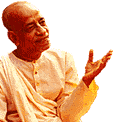Chapter 7: Knowledge of the Absolute
Bg 7.1
TEXT 1
sri-bhagavan uvaca
mayy asakta-manah partha
yogam yunjan mad-asrayah
asamsayam samagram mam
yatha jnasyasi tac chrnu
mayy asakta-manah partha
yogam yunjan mad-asrayah
asamsayam samagram mam
yatha jnasyasi tac chrnu
SYNONYMS
sri bhagavan uvaca—the Supreme Lord said; mayi—unto Me; asakta-manah—mind attached; partha—O son of Prtha; yogam—self-realization; yunjan—so practicing; mat-asrayah—in consciousness of Me (Krsna consciousness); asamsayam—without doubt; samagram—completely; mam—unto Me; yatha—as much as; jnasyasi—you can know; tat—that; srnu—try to hear.
TRANSLATION
Now hear, O son of Prtha [Arjuna], how by practicing yoga in full consciousness of Me, with mind attached to Me, you can know Me in full, free from doubt.
PURPORT
In this Seventh Chapter of Bhagavad-gita, the nature of Krsna consciousness is fully described. Krsna is full in all opulences, and how He manifests such opulences is described herein. Also, four kinds of fortunate people who become attached to Krsna, and four kinds of unfortunate people who never take to Krsna are described in this chapter.
In the first six chapters of Bhagavad-gita, the living entity has been described as nonmaterial spirit soul which is capable of elevating himself to self-realization by different types of yogas. At the end of the Sixth Chapter, it has been clearly stated that the steady concentration of the mind upon Krsna, or in other words Krsna consciousness, is the highest form of all yoga. By concentrating one's mind upon Krsna, one is able to know the Absolute Truth completely, but not otherwise. Impersonal brahmajyoti or localized Paramatma realization is not perfect knowledge of the Absolute Truth because it is partial. Full and scientific knowledge is Krsna, and everything is revealed to the person in Krsna consciousness. In complete Krsna consciousness one knows that Krsna is ultimate knowledge beyond any doubts. Different types of yoga are only steppingstones on the path of Krsna consciousness. One who takes directly to Krsna consciousness automatically knows about brahmajyoti and Paramatma in full. By practice of Krsna consciousness yoga, one can know everything in full—namely the Absolute Truth, the living entities, the material nature, and their manifestations with paraphernalia.
One should therefore begin yoga practice as directed in the last verse of the Sixth Chapter. Concentration of the mind upon Krsna the Supreme is made possible by prescribed devotional service in nine different forms, of which sravanam is the first and most important. The Lord therefore says to Arjuna, "tat srnu," or "Hear from Me." No one can be a greater authority than Krsna, and therefore by hearing from Him one receives the greatest opportunity for progress in Krsna consciousness. One has therefore to learn from Krsna directly or from a pure devotee of Krsna—and not from a nondevotee upstart, puffed up with academic education.
In the Srimad-Bhagavatam this process of understanding Krsna, the Supreme Personality of Godhead, the Absolute Truth, is described in the Second Chapter of the First Canto as follows:
srnvatam sva-katham krsnah punya-sravana-kirtanah
hrdyantahstho hy abhadrani vidbunoti suhrt satam.
hrdyantahstho hy abhadrani vidbunoti suhrt satam.
nasta-prayesv abhadresu nityam bhagavata-sevaya
bhagavaty uttama-sloke bhaktir bhavati naisthiki.
bhagavaty uttama-sloke bhaktir bhavati naisthiki.
tada rajas-tamo-bhavah kama-lobhadayas ca ye
ceta etair anaviddham sthitam sattve prasidati.
ceta etair anaviddham sthitam sattve prasidati.
evam prasanna-manaso bhagavad-bhakti-yogatah
bhagavat-tattva-vijnanam mukta-sangasya jayate.
bhagavat-tattva-vijnanam mukta-sangasya jayate.
bhidyate hrdaya-granthis chidyante sarva-samsayah
ksiyante casya karmani drsta evatmanisvare.
ksiyante casya karmani drsta evatmanisvare.
"To hear about Krsna from Vedic literatures, or to hear from Him directly through the Bhagavad-gita, is itself righteous activity. And for one who hears about Krsna, Lord Krsna, who is dwelling in everyone's heart, acts as a best-wishing friend and purifies the devotee who constantly engages in hearing of Him. In this way, a devotee naturally develops his dormant transcendental knowledge. As he hears more about Krsna from the Bhagavatam and from the devotees, he becomes fixed in the devotional service of the Lord. By development of devotional service one becomes freed from the modes of passion and ignorance, and thus material lusts and avarice are diminished. When these impurities are wiped away, the candidate remains steady in his position of pure goodness, becomes enlivened by devotional service and understands the science of God perfectly. Thus bhakti-yoga severs the hard knot of material affection and enables one to come at once to the stage of 'asamsayam samagram,' understanding of the Supreme Absolute Truth Personality of Godhead." (Bhag. 1.2.17-21)
Therefore only by hearing from Krsna or from His devotee in Krsna consciousness can one understand the science of Krsna.
Copyright (c) 1972 by His Divine Grace A.C. Bhaktivedanta Swami Prabhupada











